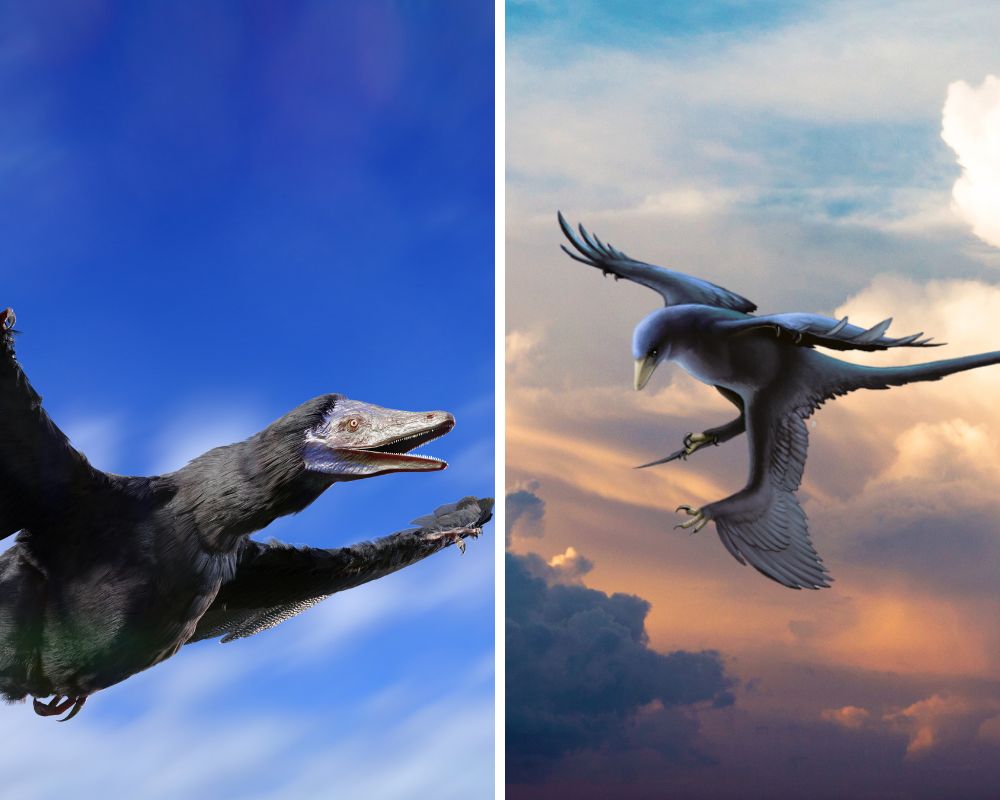Get ready because the feathers are about to fly! Who will win in this epic battle of the ancient early bird dinos? The four wings of the Microraptor could give it a slight edge, but the impressive flight of the Archaeopteryx would help it win.
Table of Contents
Battle Facts about Microraptor vs. Archaeopteryx

| Name | Microraptor (Microraptor zhaoianus), “one who seizes” | Archaeopteryx (Archaeopteryx lithographica), “old one” |
| Size | 2.5 feet long, 3-foot wingspan, 3 pounds | 2 feet long, 2.5-foot wingspan, 2 pounds |
| Speed | 20 mph flying (not a very good runner) | 4.5 mph |
| Offense | Excellent glider ability to swim | Potential to take off in flight rather than glide, full set of teeth |
| Defense | Swift movements in the air, long snouts sharp teeth | Had sharp teeth and claws, excellent at land travel |
| Endurance and Behavior | Spends most time in trees or above ground, they were not good runners | Ability to transition from land to air |
Were a Microraptor and an Archaeopteryx Related?
No, the Microraptor and the Archaeopteryx were not related. Still, they may help explain the evolution of birds.
The Microraptor belonged to the family tree of Dromaeosaurid or Dromaeosauridae dinosaurs, like the Velociraptor or Deinonychus. It was also related to similar flying raptors like the newly-discovered Changyuraptor yangi.
The Archaeopteryx was a smaller theropod dinosaur like the Tyrannosaurus Rex.
While phylogenetics believes these two species are the grandparents of modern birds, the Microraptor subspecies likely died out. Its only closest relative was the Anchiornis, which also had four wings. The wings on its hind legs were less functional.
What was the difference between a Microraptor and Archaeopteryx?
The Microraptor had four wings, a pair on its forelimbs, and a pair of hindwings on its hindlimb (like a biplane), and the Archaeopteryx only had two. These long feathers were excellent for gliding through the air at high speeds (up to 20 MPH) but did not possess flight feathers. This means the Microraptor could not take off in flight if it were on the ground.
The Archaeopteryx, on the other hand, had flight feathers for powered flight. This means that if it was standing on the ground, it could achieve flight like birds. At least, that’s what paleontologists believe based on fossil records.
What did the Archaeopteryx have that the Microraptor did Not?

The biggest advantage in adaptations were their impressive flight abilities. In addition to its flight feathers, the Archaeopteryx also had long tail feathers. Longer tail feathers allowed this avian-like dinosaur to easily control its flight pattern and speed, which the Microraptor could not do.
While their flying ability gets all the attention, the Archaeopteryx also had a very interesting snout. Unlike other pterosaurs, Archaeopteryx had a full set of teeth in its mouth. Microraptor specimens show sharp, serrated teeth, perfect for catching fish and small mammals. Still, the teeth on the Archaeopteryx were very similar to those found in Tyrannosaurus Rex, only much smaller.
Who would win – Microraptor or Archaeopteryx?
The Archaeopteryx would be the winner.
While the Microraptor was bigger, heavier, and had more wings than the Archaeopteryx, it was not as skilled in battle. The Archaeopteryx was similar to its ferocious cousin, the T-Rex, with heightened flying abilities and a mouth full of razor-sharp teeth.
How did the Archaeopteryx and Microraptor Capture Prey?

Unlike their non-avian dinosaur cousins, these Mesozoic dinosaurs used their flying ability to hunt their prey. The Microraptor, for instance, would perch on the high branches of a tree, waiting for a tasty snack.
Fossil records also found traces of sea creatures and fish in their stomach, which led some paleontologists to believe these skilled fliers were also good swimmers. The Archaeopteryx was a better runner than the Microraptor and could chase down prey and hold it in its powerful claws.
Where did the Archaeopteryx and Microraptor Live?
Noted specimens of the Archaeopteryx lived during the late Jurassic period in Europe. It primarily lived in what is now known as modern-day Germany. However, during the late Jurassic period, this section of Germany was closer to the equator and much more tropical than it is today.
Microraptor specimens date back to the early Cretaceous period in Liaoning, China. While they were both avian dinosaurs, they lived on different continents and missed each other by a few million years.
